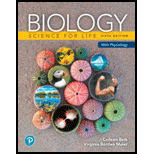
Pearson eText Biology: Science for Life with Physiology -- Instant Access (Pearson+)
6th Edition
ISBN: 9780135214114
Author: Colleen Belk, Virginia Maier
Publisher: PEARSON+
expand_more
expand_more
format_list_bulleted
Concept explainers
Question
Chapter 25, Problem 3LTB
Summary Introduction
Introduction:
Plants produce carbohydrate by the process known as photosynthesis. During photosynthesis, a plant requires carbon dioxide, water, and light to produce carbohydrate. Carbohydrates are the molecules that provide plants growth energy.
Expert Solution & Answer
Want to see the full answer?
Check out a sample textbook solution
Students have asked these similar questions
Which type of the following play a role in the gravitropic response of plants according to the statolith hypothesis?
amyloplasts
chloroplasts
receptors
calcium ions
O O O O
This plant is referred to as
This plant is referred to as
: Venus flytrap
: butterwort
: sundew
: bladderwort
Nitrogen is a vital element for plant growth, yet plants (and most other organisms) cannot access it from atmospheric nitrogen. Explain why atmospheric nitrogen is inaccessible, and describe one natural (not artificial) way that plants have evolved to obtain nitrogenous compounds, including the specific plant structures involved.
Chapter 25 Solutions
Pearson eText Biology: Science for Life with Physiology -- Instant Access (Pearson+)
Knowledge Booster
Learn more about
Need a deep-dive on the concept behind this application? Look no further. Learn more about this topic, biology and related others by exploring similar questions and additional content below.Similar questions
- Plants are living organisms that belong to the kingdom Plantae. They are multicellular eukaryotes, meaning they have cells with a nucleus and other membrane-bound organelles. Plants are characterized by their ability to produce their own food through photosynthesis, a process that involves using sunlight, carbon dioxide, and water to produce glucose (sugar) and oxygen. One stressor for a pea plant could be exposure to high salinity in the soil. To simulate this stressor, we can water the plant with a solution containing higher levels of salt than normal. To record the impact of this stressor, we can measure the height and number of leaves of the plant. We can also measure the chlorophyll content in the leaves as an indicator of the plant's ability to carry out photosynthesis. Let's say we have two groups of pea plants, one group is watered with a normal solution and the other group is watered with a high salinity solution. After two weeks, we measure the height and number of leaves of…arrow_forwardA typical plant body consists of basic organs such as roots, stems, and leaves. Over millions of years, these plant organs have become adapted for a variety of functions. Identify how each plant organ has been modified/adapted and indicate the function(s) thereof. This question can be done in table format.arrow_forwardi) list TWO adaptations that show that the plant conserves water.ii) Photosynthetic cells produce starch and may be stored. Describe how one may test for the presence of starch on a piece of potato tissue. iii) Give TWO characteristics of monocotyledonous plants. d. The transition of plants from an aquatic environment to a terrestrial one has broughtabout many evolutionary adaptations for plants to survive on land. Give ONE adaptationfor each of the following divisions:i) Mosses: ii) Gymnosperms.arrow_forward
- The _______ of a plants is made up of the stem and it's branches.arrow_forwardI’m not sure how to answer this question could please help?arrow_forward18,50 you something like this photo taken from the internet. 4 http://www.treeboss.net/tree-trunk-splotches.htm Q12. What do you think it is? Q13. Is it a plant? Q14. Give a reason for your answer in Q13. Observe these three other things your teacher prepared for you to observe: a. b. Photo credits: potato by A. Encarnacion, old banana peeling and bread by R. Reyes, and http://www.hawaii.edu/reefalgae/invasive_algae /chloro/enteromorpha_flexuosa.htm downloaded 12 March 2012for the "green stuff. CAUTION: C. Do not touch (a), (b), or (c) with your bare hands. Do not smell or taste them either. Some sensitive individuals may be allergic to them 127arrow_forward
- Angiosperm flowers are comparable to gymnosperm strobes, because both are composed of groups of __________ and __________.arrow_forwardAs shown many plants of the desert plant Lithops. How many leaves does each plant have? (By the way, even if you grow these in ideal conditions, they never have more than this number.)arrow_forwardThe first concept used to understand plants is that plantmetabolism is based on the principles of _______________and _______________. If this is true, do you think thatarrow_forward
- Sweet Potato: What is the Latin name for the genus of Sweet potato? You have to spell very carefully Which of the following plants belong into the same genus? PICK ONLY ONE OPTION: 1.) FILL IN THE BLANK 2.) Beans Carrots Corn Morning glories Willows What is the English name for the genus "Salix"? You have to spell very carefully We met this plant alrready earlier in this class, as leaf section. Where? PICK ONLY ONE OPTION: 1.) FILL IN THE BLANK 2.) As example for abnormal secondary thickening As host for the powdery mildew Uncinula As model organism in Embryo staging As example for bat pollination syndrome As example for bird pollination syndromearrow_forwardSclerophyllous foliage leaves like those in holly, barberry (as shown), and Yucca (as shown) have many unusual features. Do they live for 1 year or longer? They are more resistant to animals that might try to eat them. Why? What type of cells do they have that most leaves do not have?arrow_forwardDescribe a modified structure and function of the following plant organs: Leaf - Stem - Root -arrow_forward
arrow_back_ios
SEE MORE QUESTIONS
arrow_forward_ios
Recommended textbooks for you
 Biology 2eBiologyISBN:9781947172517Author:Matthew Douglas, Jung Choi, Mary Ann ClarkPublisher:OpenStax
Biology 2eBiologyISBN:9781947172517Author:Matthew Douglas, Jung Choi, Mary Ann ClarkPublisher:OpenStax

Biology 2e
Biology
ISBN:9781947172517
Author:Matthew Douglas, Jung Choi, Mary Ann Clark
Publisher:OpenStax